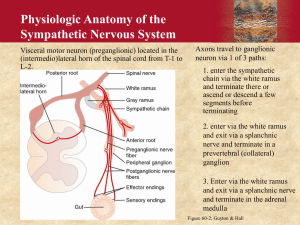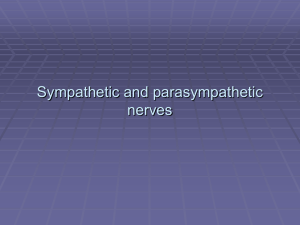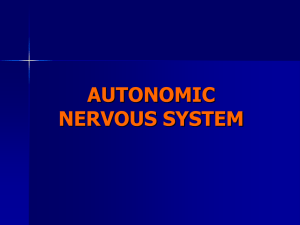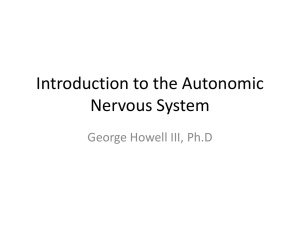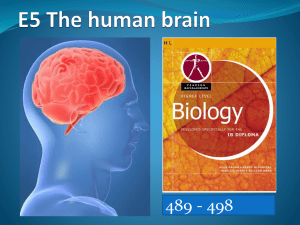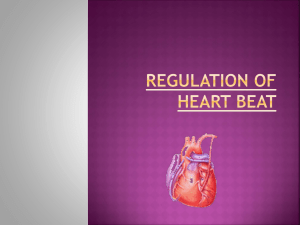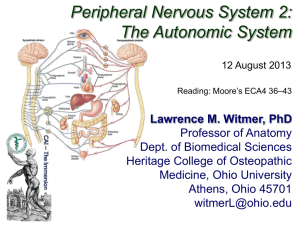Basic Characteristics of Sympathetic and
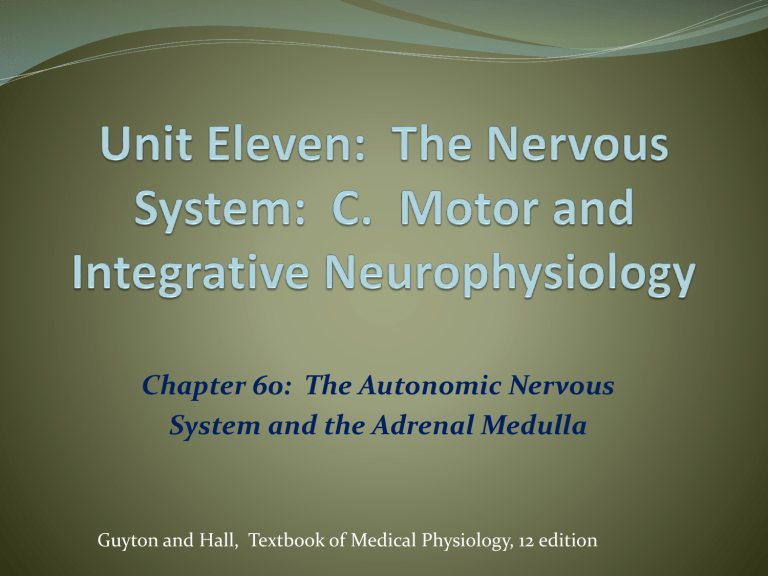
Chapter 60: The Autonomic Nervous
System and the Adrenal Medulla
Guyton and Hall, Textbook of Medical Physiology, 12 edition
General Organization of the ANS
• General Organization a. Activated mainly by centers in the spinal cord, brain stem, and hypothalamus b. Often operates through visceral reflexes c. Contains two major divisions
1. Sympathetic nervous system
2. Parasympathetic nervous system
General Organization of the ANS
• Physiologic Anatomy of the Sympathetic Nervous
System
Fig. 60.1 Sympathetic Nervous System+
General Organization of the ANS
• Preganglionic and Postganglionic Sympathetic Neurons
Fig. 60.2
General Organization of the ANS
• Segmental Distribution of the Sympathetic Nerve Fibers
(Fig. 60.1)
• Special Nature of the Sympathetic Nerve Endings in the Adrenal Medullae a. Secrete epinephrine and norepinephrine
General Organization of the ANS
• Physiologic Anatomy of the Parasympathetic Nervous
Systemabout 75% from the vagus nerve
Fig. 60.3 Parasympathetic Nervous System
General Organization of the ANS
• Preganglionic and Postganglionic Neurons a. Long preganglionic fibers b. Short postganglionic fibers c. Postganglionic neuron located very close to or in the wall of the affected organ or tissue d. a, b, and c are the opposite in sympathetic neurons
Basic Characteristics of Sympathetic and Parasympathetic Function
Preganglionic Neurons
Postganglionic Neurons
Terminal Nerve Endings
Parasympathetic
Cholinergic
Mostly cholinergic
Secrete acetylcholine
Sympathetic
Cholinergic
Mostly adrenergic
Secrete norepinephrine
Basic Characteristics of Sympathetic and Parasympathetic Function
• Mechanisms of Transmitter Secretion and
Subsequent Removal a. Secretion of AcH and norepinephrine by postganglionic nerve endings b. Synthesis of AcH, its destruction after secretion and duration of action
Basic Characteristics of Sympathetic and Parasympathetic Function
• Mechanisms of Transmitter Secretion and
Subsequent Removal c. Acetylcholinesterase-splits AcH into acetate and choline d. Synthesis of norephinephrine, its removal, and its duration of action
Basic Characteristics of Sympathetic and Parasympathetic Function
Basic Characteristics of Sympathetic and Parasympathetic Function
• Receptors on the Effector Organs a. Excitation or inhibition of the effector cell by changing its membrane permeability b. Receptor action by altering intracellular
“second messenger” cAMP
Basic Characteristics of Sympathetic and Parasympathetic Function
• Two Principle Types of Acetylcholine Receptors a. Muscarinic-found on all effector cells stimulated by postganglionic cholinergic neurons from either the sympathetic or parasympathetic divisions b. Nicotinic-found in the autonomic ganglia at the synapses between pre- and postganglionic neurons of both sympathetic and parasympathetic divisions
Basic Characteristics of Sympathetic and Parasympathetic Function
• Adrenergic Receptors-Alphas and Betas
Alpha Receptor
Vasoconstriction
Iris dilation
Intestinal Relaxation
Intestinal Sphincter Contraction
Pilomotor Contraction
Bladder Sphincter Contraction
Inhibits Neurotransmitter Release
(Alpha-2)
Beta Receptor
Vasodilation (Beta-2)
Cardioacceleration (Beta-1)
Increased myocardial strength (Beta-1)
Intestinal and uterine relaxation (Beta-2)
Bronchodilation (Beta-2)
Calorigenesis (Beta-2)
Glycogenolysis and Bladder Wall Relaxation
(Beta-2)
Lipolysis (Beta-1)
Thermogenesis (Beta-s)
Basic Characteristics of Sympathetic and Parasympathetic Function
• Excitatory and Inhibitory Actions of Sympathetic and Parasympathetic Stimulation a. Sympathetic stimulation causes excitatory effects in some organs but inhibitory effects in others b. Parasympathetic likewise is excitatory or inhibitory depending on the organ affected c. See Table 60.2 in the textbook
Basic Characteristics of Sympathetic and Parasympathetic Function
• Function of the Adrenal Medullae a. Stimulation of the sympathetic nerves causes large quantities of epinephrine and norepinephrine to be released into the blood.
b. Typically, 80% of the secretion is epinephrine and
20% norepinephrine c. Have the basic same effect as direct sympathetic stimulation except it lasts 5-10 times longer
Basic Characteristics of Sympathetic and Parasympathetic Function d. Epinephrine have almost the same effects but differences do occur in
1. Epinephrine has a greater effect on cardiac stimulation because it stimulates beta receptors
2. Epinephrine causes weaker constriction of blood vessels but increases CO
3. Norepinephrine greatly increases the total peripheral resistance and elevates arterial pressure
Basic Characteristics of Sympathetic and Parasympathetic Function
4. Epinephrine as 5-10 greater metabolic effect
• Value of the Adrenal Medullae to the Function of the Sympathetic Nervous System a. Epinephrine and norepinephrine are generally released at the same time as sympathetic stimulation b. Also stimulate areas that do not have sympathetic innervation
Basic Characteristics of Sympathetic and Parasympathetic Function
• Relation of Stimulus Rate to Degree of Sympathetic and Parasympathetic Effect a. Only a low frequency of stimulation is required for full activation of autonomic effectors
• Sympathetic and Parasympathetic Tone a. Normally, both systems are continually active b. Allows a single nervous system to both increase and decrease the activity of a stimulated organ
Stimulation of Discrete Organs in Some Instances and Mass Stimulation in Other Instances by the Sympathetic and Parasympathetic Systems
• Sympathetic System Sometimes Responds by Mass
Discharge
• Parasympathetic System Usually Causes Specific
Localized Responses
• Alarm or Stress Response of the Sympathetic
Nervous System a. Increased arterial pressure b. Increased blood flow to active muscles and decreased blood flow to GI tract and kidneys
Stimulation of Discrete Organs in Some Instances and Mass Stimulation in Other Instances by the Sympathetic and Parasympathetic Systems c. Increased rates of cellular metabolism throughout the body d. Increased blood glucose concentration e. Increased glycolysis in the liver and muscle f. Increased muscle strength g. Increased mental activity h. Increased rate of blood coagulation
Stimulation of Discrete Organs in Some Instances and Mass Stimulation in Other Instances by the Sympathetic and Parasympathetic Systems
• Medullary, Pontine, and Mesencephalic Control of the ANS
Fig. 60.5 Autonomic control areas in the brain stem and hypothalamus

